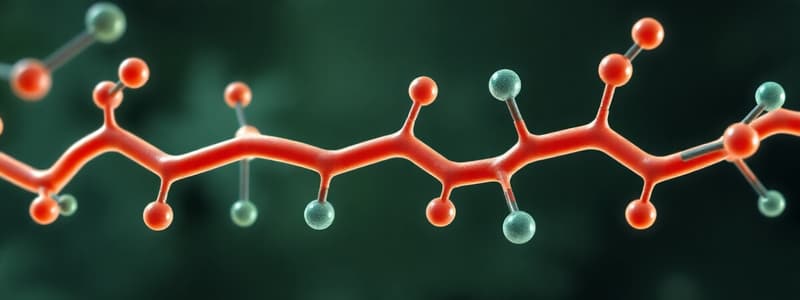Podcast
Questions and Answers
What is the primary function of transamination?
What is the primary function of transamination?
- To produce ATP
- To synthesize fatty acids
- To break down glucose
- To transfer an amino group from an amino acid to an α-keto acid (correct)
Transamination is an irreversible reaction.
Transamination is an irreversible reaction.
False (B)
What is the name of the enzyme that catalyzes transamination reactions?
What is the name of the enzyme that catalyzes transamination reactions?
aminotransferase
The cofactor required for transamination is ______, which is derived from vitamin B6.
The cofactor required for transamination is ______, which is derived from vitamin B6.
Match the following enzyme with their specific actions in transamination.
Match the following enzyme with their specific actions in transamination.
What is the role of glutamate in transamination?
What is the role of glutamate in transamination?
Keto acids produced in transamination can only be used for energy production.
Keto acids produced in transamination can only be used for energy production.
What type of molecule is transferred during transamination?
What type of molecule is transferred during transamination?
Transamination is a process that only occurs during amino acid synthesis.
Transamination is a process that only occurs during amino acid synthesis.
Besides converting them to other compounds, what is one fate of the keto acids produced by transamination?
Besides converting them to other compounds, what is one fate of the keto acids produced by transamination?
The enzyme ALT catalyzes the reaction of alanine to ______.
The enzyme ALT catalyzes the reaction of alanine to ______.
Match the enzyme with the reaction each catalyzes:
Match the enzyme with the reaction each catalyzes:
What is the primary role of pyridoxal phosphate (PLP) in transamination reactions?
What is the primary role of pyridoxal phosphate (PLP) in transamination reactions?
Glutamate donates its amino group directly to the urea cycle for excretion.
Glutamate donates its amino group directly to the urea cycle for excretion.
What is the main outcome of transamination?
What is the main outcome of transamination?
Transamination plays a critical role in generating non-essential amino acids.
Transamination plays a critical role in generating non-essential amino acids.
What reaction occurs when alanine and α-ketoglutarate undergo transamination?
What reaction occurs when alanine and α-ketoglutarate undergo transamination?
The cofactor required for transamination is ______.
The cofactor required for transamination is ______.
Match the following enzymes with the reactions they catalyze:
Match the following enzymes with the reactions they catalyze:
What role does glutamate play in the urea cycle?
What role does glutamate play in the urea cycle?
Which of the following statements about transamination is true?
Which of the following statements about transamination is true?
Name the enzyme responsible for catalyzing the reaction of aspartate to oxaloacetate.
Name the enzyme responsible for catalyzing the reaction of aspartate to oxaloacetate.
Match the following keto acids with their potential fates:
Match the following keto acids with their potential fates:
Which process does glutamate undergo to donate the amino group for urea cycle excretion?
Which process does glutamate undergo to donate the amino group for urea cycle excretion?
What is formed when alanine undergoes transamination with α-ketoglutarate?
What is formed when alanine undergoes transamination with α-ketoglutarate?
Flashcards
What is transamination?
What is transamination?
Transamination is the transfer of an amino group (-NH2) from an amino acid to an α-keto acid. This process allows the body to interconvert amino acids and keto acids.
What enzyme is involved in transamination?
What enzyme is involved in transamination?
Aminotransferase (also called transaminase) is the enzyme responsible for catalyzing transamination.
What cofactor is required for transamination?
What cofactor is required for transamination?
Pyridoxal phosphate (PLP), derived from vitamin B6, acts as a cofactor in transamination.
What is the purpose of transamination?
What is the purpose of transamination?
Signup and view all the flashcards
What is the role of glutamate in transamination?
What is the role of glutamate in transamination?
Signup and view all the flashcards
What happens to the keto acid produced in transamination?
What happens to the keto acid produced in transamination?
Signup and view all the flashcards
What are the key enzymes involved in transamination?
What are the key enzymes involved in transamination?
Signup and view all the flashcards
What enzyme catalyzes Transamination?
What enzyme catalyzes Transamination?
Signup and view all the flashcards
What cofactor is needed for Transamination?
What cofactor is needed for Transamination?
Signup and view all the flashcards
Is Transamination reversible?
Is Transamination reversible?
Signup and view all the flashcards
What is Glutamate's role in Transamination?
What is Glutamate's role in Transamination?
Signup and view all the flashcards
What are examples of enzymes in Transamination?
What are examples of enzymes in Transamination?
Signup and view all the flashcards
What happens to the keto acid after transamination?
What happens to the keto acid after transamination?
Signup and view all the flashcards
Give examples of enzymes involved in transamination?
Give examples of enzymes involved in transamination?
Signup and view all the flashcards
Study Notes
Transamination Overview
- Transamination is the transfer of an amino group (-NH₂) from an amino acid to an α-keto acid.
- This process allows the body to interconvert amino acids and keto acids.
- The reaction is catalyzed by enzymes called aminotransferases (or transaminases).
- A cofactor, pyridoxal phosphate (PLP), derived from vitamin B6, is essential for the reaction.
Purpose of Transamination
- Transamination is a reversible process, used in both the synthesis and degradation of amino acids.
- It's critical for generating non-essential amino acids.
- It prepares amino groups for excretion via the urea cycle by transferring them to glutamate.
- Crucially, this process is used in the synthesis and degradation of amino acids.
Transamination Reaction Mechanism
- An amino acid reacts with α-ketoglutarate, forming a keto acid and glutamate.
- Example: Alanine + α-ketoglutarate ↔ Pyruvate + Glutamate
Key Enzymes in Transamination
- Alanine aminotransferase (ALT) catalyzes the conversion of alanine to pyruvate.
- Aspartate aminotransferase (AST) catalyzes the conversion of aspartate to oxaloacetate.
Glutamate's Role
- Glutamate acts as a temporary store for amino groups.
- It delivers these amino groups to the urea cycle through oxidative deamination.
- Glutamate serves as a temporary reservoir for amino groups, donating them to the urea cycle.
Fate of Keto Acids
- Keto acids can be used for energy production in the Krebs cycle.
- They can also be converted into glucose or lipids.
Studying That Suits You
Use AI to generate personalized quizzes and flashcards to suit your learning preferences.
Description
This quiz covers the fundamental aspects of transamination, including its purpose, mechanisms, and key enzymes involved in the process. Understand how amino groups are transferred and the significance of this biochemical reaction in the synthesis of non-essential amino acids. Test your knowledge on the role of pyridoxal phosphate and notable enzymes like alanine aminotransferase.




